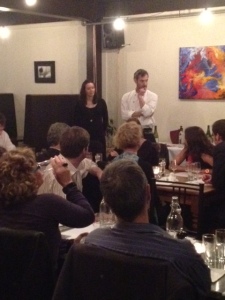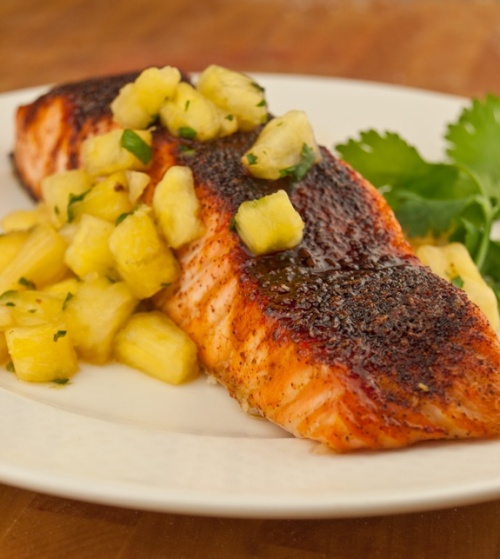
Recently the team at Wineseeker were privileged enough to hold a Spanish wine and tapas evening that combined the talents of the fabulous Ti Kouka Cafe (Central Wellington), and highly regarded Spanish wine importers, St Vincent’s Cave (Auckland). It was a fantastic opportunity to show off some of the superb Spanish wines that are available to us here in New Zealand, and to be shown how to expertly match these wines with traditional Spanish fare……with a Kiwi twist of course.
As the evening kicked off it was obvious that we were in good hands. The menus that lay in front of us were an enticing prelude to the seven magnificent wine and food courses to come. Sophie Cotter of St Vincent’s Cave began with a little background on her business. Sophie’s wine importation company is named after St Vincent, “the patron saint of wine growers and winemakers, born in Zaragoza in the late third century”, and specialises in importing Spanish wine and food into New Zealand. Sophie, a New Zealander, spent around eight years working in the wine trade in Barcelona, where she developed a passion for the diverse wines of Spain while working as an export manager for a Cava producer, and later as a buyer.
We went on to meet Shepherd Elliot, head chef at Ti Kouka Cafe, and part-owner with his brother Jesse. Shepherd’s exciting career has seen him based in many great chefing roles, including a stint at Logan Brown (a Wellington institution). These positions have led him to place great importance on the origin and sustainability of the produce that he uses. This awareness shines through in both the style and flavour of Shepherd’s cuisine.
Now that we were better acquainted with our culinary tour guides, it was on to the first course……
Jamon with Almond Picada & Olives
Wine match: Cava Beso NV – “Stress free Cava” made from Macabeo and Chardonnay grapes.
Described by its producers as “stress free cava” due to its careful cellaring in an environment with no light, no sound and no vibrations, this was the perfect place to start. The saltiness of the olives and jamon (serrano ham, slightly less fatty than iberico) was beautifully complimented by the salty, chalky notes in the Cava. Even the subtleties of the almond in the picada were picked up by the delicate biscuity, brioche notes of the wine. Delicious!
Smoked Fish Croquette with Aioli
Wine match: Valdesil Godello 2010 – “Silver Valley” (valdesil) Godello grapes are sourced from 30-40 year old vines in the Valdeorras region to produce this stunning dry white.
It was clear from the first sip that this wine might be a favourite. Typically tricky to produce from a winemaking perspective, the end result is well worth it. Valdesil Godello is a rich, fuller bodied dry wine, with subtle fruit and good acidity that carries it though to a cleansing, dry finish. This cleansing, mineral element in the wine meant that the smoky, rich flavours of the two types of fish croquette were enhanced, yet balanced. Shepherd also went with a carefully selected Wairarapa lemon olive oil, providing extra balance and depth to the dish. A superb match!
Paella with grilled King Prawn
Wine Match: Sin Palabras Albarino 2010 – from a family owned Galician winery with four generations of experience in the Rias Baixas D.O
Working with the tools that they had available, the team at Ti Kouka did a spectacular job of making paella on what would be considered “small scale” by Spanish standards. Short grained paella rice was flavoured with a base of king prawn and chicken stock. The finishing touch came in the form of just the right amount of Saffron sourced from local growers, Greytown Gold. The savoury nature of the paella worked with spicy notes in the wine, and the tropical fruit notes in the Albarino were a classic contrast to the savoury king prawn. After some discussion later in the evening, it was suggested that the Valdesil Godello may have been an even better match with this dish!
Mushroom and Rabbit Ravioli with Truffle butter sauce
Wine Match: Marques de Riscal Reserva Rioja 2006 – predominantly Tempranillo, from one of the first Spanish producers to bring French winemaking techniques to Spain.
This was a truly indulgent combination, with many voicing their enthusiasm as the dishes were brought to the table. Sophie’s description of the wine as one of the more traditional styles of Rioja was spot on. The rustic composition of ingredients, accompanied by the bucolic profile of the wine enhanced the earthy truffle notes and formed an idilic match.
Roasted Large Black pork with confit duck, braised beans, apple and fennel
Wine match: Lavia + Monastrell 2005 – 100% monastrell (also known as movedre) named after the nearby Lavia mountain range.
For me this was one of the best matches of the evening. The confit duck and roasted pork brought out plum and dark fruit flavours in this deep red monastrell. Braised beans sat well with apple and fennel, providing a freshness to what would be a very hearty dish on its own. Known for its gamey flavours and tannic structure, monastrell was well suited to cut through the richness of the dish while lifting the heavier components.
Braised beef cheek with roasted parsnip, chard and mojo verde
Wine match: Acustic Cellar Samso Garnaxta 2008 – “Acustic” refers to the hands off (unplugged) winemaking methods used throughout the production of Acustic Cellar wines.
A bit of a crowd pleaser, both the food and the wine were greatly received. Shepherd chose local grain finished beef, adding a rich flavour to the parsinip and chard combination. Mojo verde (a sauce made of wine, olive oil and nuts) topped the arrangment. The samso grape, also known as carignan, added a phenolic dryness to the wine, and the garnaxta (grenache) softened the blend, while maintaining a characteristic rustic perfume. A very good match for beef!
Crema Catalana and Whipped Tinui blue cheese with quince and walnut
Wine match: Alvea Moscatel NV – fondly called the “High Low Wine” at its 300 year old winery source, this complex sweet wine is known to be “high” in taste, but “low” in price.
What an outstanding way to complete the menu. The crème catalana, complete with crushed pecan nuts on top, merged deliciously with the warm, honeyed and nutty notes in the wine. In total contrast, the salty blue cheese whip with quince and walnut was a satisfying match with the sweet, fortified moscatel, rounding off the dish nicely.
The verdict…..Everyone had their favourites, but all agreed, the wine and food matches were an overall success! The highlight for me, without a doubt, was the jamon with almond picada and olives matched with Cava Beso. Simple, I know, but I was most impressed with this delicate combination of savoury flavours that worked so well together.







